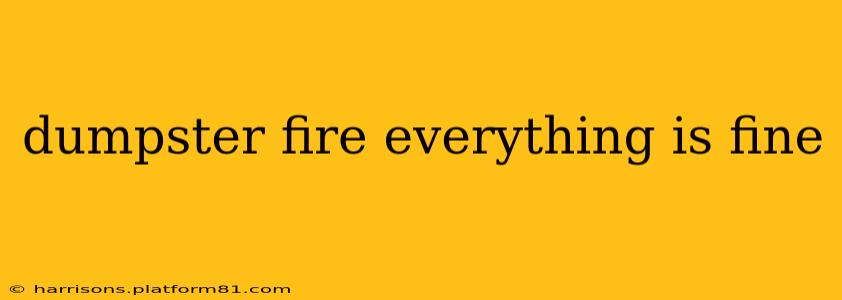Decoding "Dumpster Fire: Everything is Fine" – A Look at the Ironic Meme
The phrase "dumpster fire: everything is fine" is more than just a catchy meme; it's a potent symbol of the modern human experience, reflecting our tendency to downplay chaos and maintain a facade of normalcy amidst overwhelming problems. It perfectly encapsulates the ironic disconnect between reality and outward appearances. This post will explore the origins, meaning, and evolving usage of this phrase, examining its application in various contexts.
What does "Dumpster Fire: Everything is Fine" mean?
At its core, the phrase represents a jarring juxtaposition. "Dumpster fire" vividly depicts a scene of utter chaos, destruction, and uncontrolled disaster. In contrast, "everything is fine" projects an image of calm and composure, a stark denial of the obvious calamity. The humor, and the underlying anxiety, arises from this deliberate dissonance. It speaks to situations where things are clearly going wrong, yet a superficial calm is maintained, often out of necessity, fear, or a desperate attempt to avoid facing the severity of the problem.
What is the origin of the "Dumpster Fire: Everything is Fine" meme?
Pinpointing the exact origin is difficult, as the meme likely evolved organically across various online platforms. However, its popularity soared around 2016-2017, fueled by increasing political and social unrest. The image of a literal dumpster fire coupled with the nonchalant "everything is fine" caption became a powerful visual representation of the feeling that many people were experiencing during that tumultuous time. It tapped into a shared sentiment of helplessness and ironic detachment in the face of overwhelming negativity.
What situations does "Dumpster Fire: Everything is Fine" describe?
This phrase applies to a surprisingly broad range of situations. Here are a few examples:
-
Work-related stress: A project is falling apart, deadlines are missed, and the team is under immense pressure, yet the outward appearance is one of controlled chaos. Management might insist "everything is fine" while internally panicking.
-
Personal relationships: A relationship is crumbling, communication breaks down, and fundamental issues remain unaddressed, but the couple publicly portrays a picture of marital bliss.
-
Political climate: Significant political and social turmoil is happening, yet some individuals maintain an air of indifference or outright denial.
-
Financial struggles: An individual or family is facing severe financial hardship, but pretends everything is alright to avoid embarrassment or seeking help.
Essentially, "Dumpster fire: everything is fine" describes situations where the reality of a significant problem is masked by a false sense of normalcy or control.
How is "Dumpster Fire: Everything is Fine" used in different contexts?
The meme's versatility allows for its adaptation across various contexts. It's used humorously, sarcastically, and sometimes even as a cry for help. The tone depends entirely on the situation and the user's intention. The image itself can range from literal dumpster fires to more metaphorical illustrations of chaos – a messy desk, a cluttered room, or even a complicated spreadsheet.
Is "Dumpster Fire: Everything is Fine" just a meme, or does it reflect deeper societal issues?
The meme's enduring popularity suggests that it resonates with a deep-seated human tendency to avoid confronting difficult realities. It highlights the pressures we face to maintain a positive public image, even when our inner experience is significantly different. It's a commentary on our societal expectations, the pressures of perfection, and the often-unhealthy coping mechanisms we adopt to deal with stress and anxiety.
In conclusion, "dumpster fire: everything is fine" is more than just a funny meme; it's a reflection of our modern experience, an ironic commentary on our tendency to downplay chaos and maintain a veneer of normalcy even when facing significant adversity. Its adaptability and continued relevance showcase its power as a potent symbol of our times.
